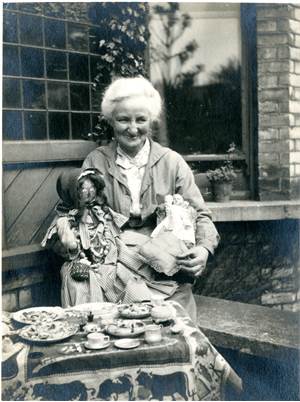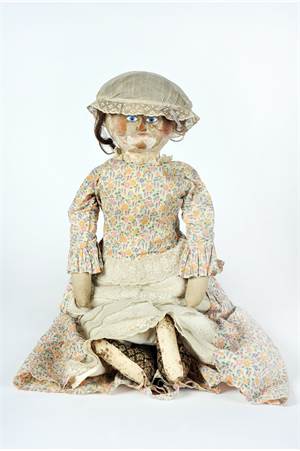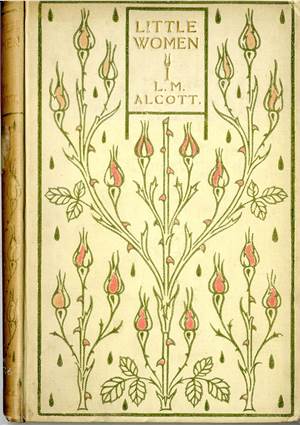The Murray Book Collection
The Murray Book Collection
The Murray Book Collection is part of the Maria Grey College Archives. It was originally the E.R.Murray Memorial Library at Maria Grey College, a predecessor college of Brunel University London.
E.R.Murray

Elsie Riach Murray was born in Edinburgh in 1861. In 1893, at the age of 33, much older than the majority of students, she became a student at Maria Grey College. She had not studied the work of Friedrich Froebel before that time but once at College ‘simply absorbed his writings’. After her training she was head of the preparatory department at Chiswick High School for three years then returned to Maria Grey College to take up the post of head of Kindergarten in 1898. She was to remain in post until retirement in 1926, becoming Vice-Principal in 1914, and establishing the College as a centre of the Froebelian movement. She was an inspirational teacher, treating students with courtesy and respect and children with infinite patience. Her methods included Kindergarten birthday parties for Dorothy, an antique doll now residing in the Archives.

The early days of the Kindergarten movement had seen the adoption of the teachings of Friedrich Froebel and these were followed on often rigid lines by teachers of his method. These included Elenore Heerwart who managed the kindergarten at Stockwell College, a college of the British and Foreign School Society, the records of which are also held in Brunel University London Archives. Froebel recognised the importance of play and activity in learning and he designed educational play materials which included building blocks and pattern weaving. Fluent in German, Murray was able to reinterpret Froebel’s teachings. Realising that Froebel had meant his methods as applications and examples of his principles and not as law to be followed without deviation, she substituted a more liberal interpretation. Murray’s teaching emphasised child development alongside the direct study of Frobelian texts and, as a result, rejected the more rigid adoption of method and apparatus in favour of observation, understanding and working with children. She wrote of these ideas in a series of articles for the journal Child Life. These articles, and in particular her series What to teach for the next three months, were eagerly awaited by students and teachers alike.
Murray wrote of her understanding of Froebel’s writings in a number of books that became classic texts in the history of education: Froebel as a pioneer, Infant schools and kindergartens and The child under eight, copies of which are held in the Archives. Her explorations of other theorists in the education of children led her to visit Italy to study the Montessori Method. At first an enthusiast, she changed her mind when she observed the series of apparatus that Dr. Montessori had designed to ‘train the senses’. Murray felt this was ‘unpsychological’. ‘The teacher should provide or let her children provide material, sand beyond everything, and clay, paper and pencils, bits of cloth and ribbon, chestnuts and acorns, empty match boxes, crayons, picture books, balls etc., etc., guided by Froebel’s rules that a child’s toys shall be such as will incite activity, both mental and bodily’. Although she admired Dr. Montessori’s enthusiasm and devotion to the education of young children, she was not swayed from her dedication to Froebelian principles.
In addition to her teaching and writing, Murray campaigned for recognition of Froebelian teachers. She was on the Council of the Froebel Society and the Board of the National Froebel Union and lectured throughout England and Wales, though she had to accept that her native Scotland would never adopt Froebelian ideals. In 1922 she was able to write that the Board of Education was ready to give grants to students studying at Froebel colleges, giving them the same recognition as students in state colleges.
‘Her study and re-interpretation of the Froebelian texts, her involvement in the new child-study movement and her knowledge of the importance of Dewey’s theories in the development of psychological studies all contributed to her importance as an educator.’ The dedication of the Library in E.R.Murray’s memory would describe her as ‘Our greatest Froebelian’.
The Murray Book Collection

The Murray Book Collection forms part of the Maria Grey College Archives. It consists of over 700 books devoted to the interests of children, including children’s stories from Murray’s own collection. Items were added after her death, as a “Memorial Library”, with a contribution of £148 from the Old Students’ Association. Among the contributors were past children and parents of the Kindergarten, old students, colleagues and personal friends. A bookplate was designed by Miss Jarvis. A catalogue of the 332 books of the original collection was listed in the Maria Grey College Magazine of 1934, with further lists of additions to the library in the magazines of 1937, 1939 and 1943.
The collection contains books published in the nineteenth and early twentieth centuries and includes both fiction and non-fiction books for children as well as texts on educational theory. Children’s books of the early nineteenth century tended to concentrate on moral tales for little ones and most have an uplifting and often a religious message. There are few illustrations. Examples are ‘Parliament in the playroom’ by an author given as A.L.O.E. (A lady of England) and the ‘Moral lessons’ and ‘Moral tales’ of Maria Edgeworth. Julia Horatia Ewing was a prolific author of children’s stories such as ‘Jackanapes’, ‘Lob lie by the fire’ and ‘Mrs Overtheway’s remembrances’ and there are copies of these and her other works in the collection. There are many examples of more adventurous and imaginative tales and the Library contains fairy stories by Hans Anderson and George Macdonald, legends of King Arthur and other heroes, poetry and songs for children, school adventures by Susan Coolidge and Angela Brazil and nine Doolittle story books by High Lofting. There are examples, too, of the beautiful illustrations of Edmund Dulac and Arthur Rackham. The subject of children’s education and, of course, the work of Friedrich Froebel is not neglected, the collection contains a number of Murray’s own copies of books by Froebel and Pestalozzi in German.
The Murray Book Collection catalogue is available online.